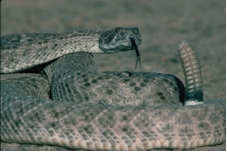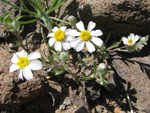Time to start watching for venomous critters
April 7, 2010
Rattlers, scorpions, lizards ready to feed
KINGMAN, Ariz. – Welcome to springtime in Arizona; home to the most dangerous rattlesnake, spider, lizard, and scorpion in the nation.
 The temperatures are rising and those slithering, crawling, burrowing, and web-spinning critters are ready to eat.
The temperatures are rising and those slithering, crawling, burrowing, and web-spinning critters are ready to eat.
The Arizona Game and Fish Department reminds the public these venomous insects and reptiles become active this time of year, and people who take the time to learn and educate themselves and their children can minimize the likelihood of a dangerous encounter.
“It’s just about time,” said Zen Mocarski, public information officer at the Game and Fish Kingman office. “After a winter of inactivity, they’re ready for their first meals of the year.
“Spiders, scorpions, rattlesnakes, the Gila monster, and a variety of other critters are part of life in Arizona. As it warms up, they’ll become increasingly more visible.”
Mocarski worries most about young children who have a natural curiosity of their surroundings.
“Parents need to teach children not to pick up any type of wildlife,” he said. “Teach your kids to come and get you when they see something.”
The most commonly encountered rattlesnake in Arizona is the western diamondback, which also accounts for the most bites. And, while there is no such thing as a typical rattlesnake bite, the Mohave is accepted as the most dangerous, although the potency of its venom can vary from region-to-region.
“What’s the most dangerous rattlesnake?” Mocarski asked. “The one that bit you.”
Mocarski said accidental bites are rare and many incidents involve alcohol. However, if bitten, the rules to follow are simple.
“Remove any restrictive clothing and jewelry and get to a medical facility as quickly as possible,” he explained. “Forget what you’ve seen in movies and get treatment with anti-venom.
“Do not cut open the bite area and try to suck out the venom, don’t submerge the bite area in ice, and do not tie off the area with a tourniquet.”
While approximately 30 percent of rattlesnake bites are considered dry bites – those that do not require anti-venom treatment – a medical professional should make that determination.
In addition, do not spend time trying to capture or collect the rattlesnake. Identification is not necessary for treatment.
Understanding wildlife behavior can go a long way in avoiding bites and stings.
Rattlesnakes are cold blooded and have to work to try and maintain an ideal body temperature. During cooler times, such as evening hours, rattlesnakes will seek out a heat source such as pavement. During the heat of the day, they will seek shade.
Mocarski added that it is a myth that rattlers will always rattle before a strike.
“It’s our jobs to take certain precautions,” Mocarski said. “Keep a close eye on the sides of trails and never place your hands and feet in an area you can’t see.”
As for dogs, Mocarski said encounters with rattlesnakes can be dangerous.
“Dogs tend to be bitten around the face and neck,” he explained. “Training can help, but keeping your pet on a leash and close to your side will help avoid bites that occur as a result of a dog’s natural curiosity.”
For scorpions and spiders, Mocarski said to wear gloves when working around wood or rock piles and to shake out shoes that have been left outside. He added that open-toed shoes provide little protection.
Most scorpion stings are comparable to that of a bee. However, the sting of the bark scorpion can be more severe. Its sting can be harmful to young children, the elderly, and individuals in poor health.
While all spiders are venomous, two factors must exist to be considered a threat to humans: the venom must be strong enough to do damage, and their jaws must be able to break human skin. With these factors in mind, two spiders in the area are considered dangerous to humans: the brown (a relative of the brown recluse), and the black widow.
The Gila monster is the only venomous lizard in North America. Its bite is extremely painful and can result in vomiting and convulsions. The Gila monster is also notorious for not letting go, and victims have been known to show up at an emergency room with the lizard still attached.
“A Gila monster bite is not something an individual wants to experience,” Mocarski said. “The good news is that if people leave them alone, they’ll leave the people alone. I’ve never heard of an accidental Gila monster bite.”
Mocarski added that the Gila monster is protected and it is illegal to disturb, capture, or kill one. It is rarely seen, spending much of its life underground.
“All these animals are important parts of the ecosystem,” Mocarski explained. “Rattlesnakes help keep rodent populations under control while scorpions and spiders feast on a number of different types of insects.
“They’ve been here a long time. It’s our job to learn to live with them, not their job to learn to live with us.”
Weight, wellness program focuses on behavioral, lifestyle changes
April 7, 2010
Scottsdale Healthcare's 'Psychology of Lasting Weight Loss and Well-being' starts April 29
SCOTTSDALE - Whether you reach for a doughnut because you're depressed or you simply overeat, Scottsdale Healthcare's Psychology of Lasting Weight Loss and Well-being program can help you lose weight for good. The 10-week program begins April 29.
Participants will attend weekly classes, conducted by Lisa Galper, PsyD, a psychologist with more than 20 years of personal and professional experience in the field of weight loss.
Participants also will receive:
• a wellness evaluation at the beginning and end of the program
• a one-hour appointment with a registered dietitian
• a one-hour appointment with an exercise physiologist
• one-on-one weekly coaching
• a fitness membership, for the duration of the program, at Scottsdale Healthcare's Essential Touch Wellness Center & Boutique
The Psychology of Lasting Weight Loss and Well-being program is held from 6-7:30 p.m. at Scottsdale Healthcare Shea Medical Center, 9003 E. Shea Blvd, in the 5th-floor classroom. The cost is $359. For information or to register call 480-882-4636.

 The most color and diversity can be found by hiking the western half of the Spur Cross Regional Trail and the southern section of the Elephant Mountain Trail – particularly on the south facing slopes. Annuals found in this area include fiddleneck, combseed, filaree, desert hyacinth, Gordon’s bladderpod, popcorn flower, Coulter’s & Arizona lupine, gilia, desert anemone, Arizona fiesta flower, desert chia, red maids, scorpion weed, wild heliotrope, eucrypta, desert chicory, owl clover, yellow spiny aster, California mustard, Easter bonnets, plantago, lace pod, New Mexico thistle, mustard evening primrose and bottle evening primrose. Some groupings of Mexican poppies can be found toward the western end of the Spur Cross Trail although not as heavy as in previous years. Indian paintbrush can be found on the north slope of Elephant Mountain. Perennials blooming include jojoba, deer vetch, fairy duster, brittlebush, creosote bush, desert lavender, bush penstemon, desert wishbone bush, goldeneye, desert globemallow, desert phlox, ephedra, and ocotillo. The strawberry hedgehog cacti are now starting to flower. These trails require more hiking and are more difficult to reach so bring a hat, plenty of water, and good hiking boots.
The most color and diversity can be found by hiking the western half of the Spur Cross Regional Trail and the southern section of the Elephant Mountain Trail – particularly on the south facing slopes. Annuals found in this area include fiddleneck, combseed, filaree, desert hyacinth, Gordon’s bladderpod, popcorn flower, Coulter’s & Arizona lupine, gilia, desert anemone, Arizona fiesta flower, desert chia, red maids, scorpion weed, wild heliotrope, eucrypta, desert chicory, owl clover, yellow spiny aster, California mustard, Easter bonnets, plantago, lace pod, New Mexico thistle, mustard evening primrose and bottle evening primrose. Some groupings of Mexican poppies can be found toward the western end of the Spur Cross Trail although not as heavy as in previous years. Indian paintbrush can be found on the north slope of Elephant Mountain. Perennials blooming include jojoba, deer vetch, fairy duster, brittlebush, creosote bush, desert lavender, bush penstemon, desert wishbone bush, goldeneye, desert globemallow, desert phlox, ephedra, and ocotillo. The strawberry hedgehog cacti are now starting to flower. These trails require more hiking and are more difficult to reach so bring a hat, plenty of water, and good hiking boots. At lower elevations in the conservation area such as the eastern section of the Spur Cross, Dragonfly, Metate, and Towhee Trails, annuals found include fiddleneck, filaree, combseed, eucrypta, desert hyacinth, popcorn flower, Gordon’s bladderpod, wild heliotrope, scorpionweed, Arizona fiesta flower, desert chia, Coulter’s lupine, desert marigold, gilia, New Mexico thistle, globe chamomile, London rocket, and desert chicory. Perennials in bloom in this area include jojoba, fairy duster, creosote bush, scarlet bugler penstemon, deer vetch, brittlebush, desert wishbone bush, ocotillo, and desert globemallow. The strawberry hedgehog cacti are now starting to flower. On the floodplain along the Metate and Dragonfly Trails, wild cucumber and canaigre can also be seen in bloom.
At lower elevations in the conservation area such as the eastern section of the Spur Cross, Dragonfly, Metate, and Towhee Trails, annuals found include fiddleneck, filaree, combseed, eucrypta, desert hyacinth, popcorn flower, Gordon’s bladderpod, wild heliotrope, scorpionweed, Arizona fiesta flower, desert chia, Coulter’s lupine, desert marigold, gilia, New Mexico thistle, globe chamomile, London rocket, and desert chicory. Perennials in bloom in this area include jojoba, fairy duster, creosote bush, scarlet bugler penstemon, deer vetch, brittlebush, desert wishbone bush, ocotillo, and desert globemallow. The strawberry hedgehog cacti are now starting to flower. On the floodplain along the Metate and Dragonfly Trails, wild cucumber and canaigre can also be seen in bloom.